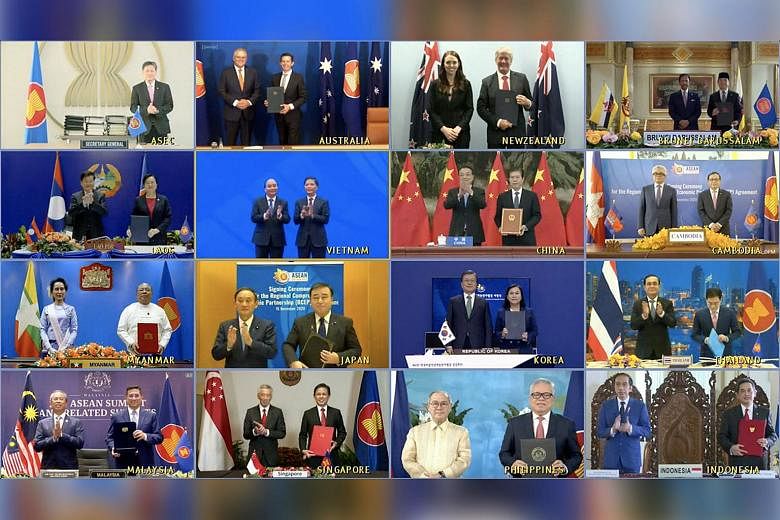ISLAMABAD (DAWN/ASIA NEWS NETWORK) - With the signing of Regional Comprehensive Economic Partnership (RCEP), Pakistan finds itself in a situation reminiscent of Alice in Wonderland, having to run just to stay still.
Interpreted in the RCEP context, if we are to retain our status quo position with market access, we must renegotiate or fall behind. How does a trade agreement that Pakistan is not a part of put it in this predicament?
The Asean-centred RCEP was signed on Nov 15. Ten of the 15 member countries are already members of Asean and the remaining five are FTA partners of Asean (China, Japan, South Korea, Australia, and New Zealand).
Together, they have a population of 2.2 billion and a share of 30 per cent of the world's output, making RCEP one of the biggest free trade agreements in history.
Like other trade agreements, it sets out terms of trade in goods and services. However, trade between the RCEP members was already fairly liberalised with respect to tariffs, so while tariffs will decline further, there was not much room for improvement.
The big new gains to RCEP members are in the ease of movement of goods, services and investment, which will lead the members to not just trade more with each other, but to form smoother and lower-cost regional and global value chains and undertake joint ventures and investments more readily in other member countries.
Key to this is a unified rule of origin which means that products manufactured to RCEP-originating criteria can move freely within the bloc with a single certificate of origin, slashing administrative time, complications and costs of sourcing inputs within the region.
Consequently, RCEP countries are likely to become more cost-effective and competitive.
There are at least two critical areas where this will have spillover implications for Pakistan: exports and foreign direct investment (FDI).
A sixth of Pakistan's exports are destined for RCEP countries. As RCEP members find it easier and cheaper to trade with each other, there is likely to be some trade diversion away from Pakistan towards fellow RCEP members.
The tariff offered to Pakistan by RCEP countries, while it remains unchanged, is now higher relative to RCEP competitors. We saw this after the first phase of Pakistan's FTA with China, signed 2007.
Within three years, China had signed an FTA with Asean which eroded Pakistan's preference margins. We will see this again with RCEP.
The larger loss to Pakistan, however, is likely to arise from the greater competitiveness of RCEP countries in international markets.
Many of the RCEP member countries (in particular China, Vietnam, Indonesia, Cambodia, Myanmar and Thailand) are Pakistan's direct competitors in our main export markets: the US and Europe, and for our main export categories: textiles and garments.
With RCEP-related improvements in their competitiveness, they are likely to gain market share over Pakistan.
The second big potential issue for Pakistan is FDI. As with trade in goods and services, the RCEP agreement makes capital flows and investments in partner countries smoother and less expensive.
As a destination for outsourcing production and linking value chains for major global firms, this is likely to make Pakistan less attractive vis-à-vis RCEP member countries.
This is true of investment originating from within RCEP countries, and for investment outside the bloc as well, both of which are now likely to see some diversion to RCEP countries.
Paradoxically, the saving grace for Pakistan is that it is not a large trading nation and receives just 0.1,per cent of world FDI.
Moreover, most of Pakistan's FDI at the moment is market seeking (ie it comes for the large consumer market) for which costs of production are relatively less important.
Secondly, the large chunk of FDI that Pakistan has received recently is not from private firms. State-led investments are unlikely to be impacted by RCEP.
Still, attracting efficiency-seeking investment and global value chain partners must remain a priority for Pakistan to improve FDI and exports sustainably.
Competitiveness relative to other countries is a prerequisite for this. With RCEP, this is now at the risk of being eroded further.
It is imperative for Pakistan to position itself to engage more deeply with regional initiatives and build the capacity to negotiate bilateral and multilateral agreements more strategically.
The terms negotiated in Pakistan's existing FTAs might seem static, but seen in the context of a region progressing steadily towards better and better trade deals, Pakistan will need to keep running just to stand still.
The writer teaches economics at the Lahore University of Management Sciences. The paper is a member of The Straits Times media partner Asia News Network, an alliance of 24 news media organisations.

